Itagaki Taisuke
- For information on the warrior woman, see Itagaki
| Itagaki Taisuke | |
|---|---|
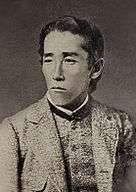 | |
| Born |
May 21, 1837 Tosa Domain, Japan |
| Died | July 16, 1919 (aged 82) |
| Nationality | Japanese |
| Occupation | Politician, Cabinet Minister |
Count Itagaki Taisuke (板垣 退助, 21 May 1837 – 16 July 1919) was a Japanese politician and leader of the Freedom and People's Rights Movement (自由民権運動 Jiyū Minken Undō), which evolved into Japan's first political party. His image is on Japan's 1953 100-yen banknote.
Biography
Early life
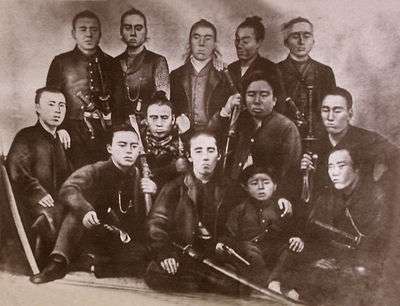
Itagaki Taisuke was born into a middle-ranking samurai family in Tosa Domain, (present day Kōchi Prefecture), After studies in Kōchi and in Edo, he was appointed as sobayonin (councillor) to Tosa daimyo Yamauchi Toyoshige, and was in charge of accounts and military matters at the domain's Edo residence in 1861. He disagreed with the domain’s official policy of kōbu gattai (reconciliation between the Imperial Court and the Tokugawa shogunate), and in 1867-1868, he met with Saigō Takamori of the Satsuma Domain, and agreed to pledge Tosa's forces in the effort to overthrow the Shogun in the upcoming Meiji Restoration. During the Boshin War, he emerged as the leading political figure from Tosa domain, and claimed a place in the new Meiji government after the Tokugawa defeat.
Meiji statesman to liberal agitator
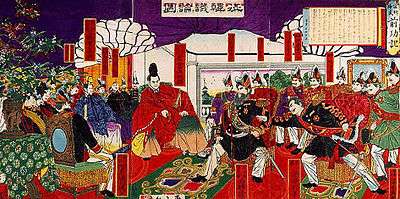

Itagaki was appointed a Councilor of State in 1869, and was involved in several key reforms, such as the abolition of the han system in 1871. As a sangi (councillor), he ran the government temporarily during the absence of the Iwakura Mission.
However, Itagaki resigned from the Meiji government in 1873 over disagreement with the government's policy of restraint toward Korea (Seikanron) and, more generally, in opposition to the Chōshū-Satsuma domination of the new government.
In 1874, together with Gotō Shōjirō of Tosa and Etō Shimpei and Soejima Taneomi of Hizen, he formed the Aikoku Kōtō (Public Party of Patriots), declaring, "We, the thirty millions of people in Japan are all equally endowed with certain definite rights, among which are those of enjoying and defending life and liberty, acquiring and possessing property, and obtaining a livelihood and pursuing happiness. These rights are by Nature bestowed upon all men, and, therefore, cannot be taken away by the power of any man." This anti-government stance appealed to the discontented remnants of the samurai class and the rural aristocracy (who resented centralized taxation) and peasants (who were discontented with high prices and low wages). Itagaki's involvement in liberalism lent it political legitimacy in Japan, and he became a leader of the push for democratic reform.
Itagaki and his associations created a variety of organizations to fuse samurai ethos with western liberalism and to agitate for a national assembly, written constitution and limits to arbitrary exercise of power by the government. These included the Risshisha (Self-Help Movement) and the Aikokusha (Society of Patriots) in 1875. After funding issues led to initial stagnation, the Aikokusha was revived in 1878 and agitated with increasing success as part of the Freedom and People's Rights Movement. The Movement drew the ire of the government and its supporters. In 1882, Itagaki was almost assassinated by a right-wing militant, to whom he allegedly said, "Itagaki may die, but liberty never!"[1]
Leadership of the Liberal Party
Government leaders met at the Osaka Conference of 1875, enticing Itagaki to return as a sangi (councilor): however, he resigned after a couple of months to oppose what he viewed as excessive concentration of power in the Genrōin.
Itagaki created the Liberal Party (Jiyuto) together with Numa Morikazu in 1881, which, along with the Rikken Kaishintō, led the nationwide popular discontent of 1880-1884. During this period, a rift developed in the movement between the lower class members and the aristocratic leadership of the party. Itagaki became embroiled in controversy when he took a trip to Europe believed by many to have been funded by the government. The trip turned out to have been provided by the Mitsui Company, but suspicions that Itagaki was being won over to the government side persisted. Consequently, radical splinter groups proliferated, undermining the unity of the party and the Movement. Itagaki was offered the title of Count (Hakushaku) in 1884, as the new peerage system known as kazoku was formed, but he accepted only on the condition that the title not be passed on to his heirs.
The Liberal Party dissolved itself on 20 October 1884. It was reestablished shortly before the opening of the Imperial Diet in 1890 as the Rikken Jiyūtō.
In April 1896, Itagaki joined the second Itō administration as Home Minister. In 1898, Itagaki joined with Ōkuma Shigenobu of the Shimpotō to form the Kenseitō, and Japan's first party government. Ōkuma became Prime Minister, and Itagaki continued serving as Home Minister. The Cabinet collapsed after four months of squabbling between the factions, demonstrating the immaturity of parliamentary democracy at the time in Japan. Itagaki retired from public life in 1900 and spent the rest of his days writing. He died of natural causes in 1919.
 |
 |
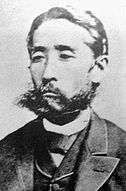 |
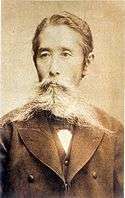 |
 |
1868 (31 years old) |
1880 (44 years old) |
about 1886 (about 50 years old) |
about 1896 (about 60 years old) |
about 1906 (about 70 years old) |
Legacy
_-_front.jpg)

Itagaki is credited as being the first Japanese party leader and an important force for liberalism in Meiji Japan. He was elevated to the peerage posthumously, and given the rank of hakushaku (count).
His portrait has appeared on the 50-sen and 100-yen banknotes issued by the Bank of Japan.
Family crest of Itagaki clan
 |
 |
 |
Jigurobishi |
Kayanouchi Jumonji |
Tosa kiri |
Genealogy
- Inui family(Itagaki family) Their clan name is Minamoto(Seiwa-Genji).
In this house, Edo period was a samurai in the Tosa clan from generation to generation. Knight(senior samurai).[2] Original Itagaki used "Jiguro-bishi (Kage-hanabishi)" for the family crest with Takeda of the effect for the same family.[3] However, Inui used "Kayanouchi Jumonji"(Aduchi Period - Meiji Period), "Tosa Kiri"(Meiji Period - now).[4]
∴Itagaki Suruganokami Nobukata ┃ ┣━━━━━━━━━━━━━━━┳━━━━━━━━━━━━━━┓ ┃Itagaki Yajiro ┃Sakayori Seizaburo ┃Ozo(Itagaki) Nobuyasu's wife Nobunori Masamitsu woman ┃ ┃ ┃Inui Kahei Masanobu ┃ ┃ ┃Inui Kinemon Masayuki ┃ ┣━━━━━━━━━━━━━━━━━━━━━━━━━━━━━━━━┳━━━━━━━━┓ ┃Inui Yosobei ┃Inui Ichirobei┃Inui Gengoro Masasuke Masanao Tomomasa ┃ ┃ ┣━━━━━━━━━━━━━━━━━┓ ┃ ┃Inui Shoemonnojyo ┃Inui Jyujiro ┃Inui Shichirozaemon Masakata unknown Masafusa ┃ ┃ ┃ ┣━━━━━━┓ ┃ ┃ ┃Inui Kasuke┃Inui Yosozaemon ┃Inui Tosuke ┃Inui Yagobei unknown Masakiyo unknown Yoshikatsu ┃ ┃ ┏━━━━━━╋━━━━━━━┳━━━━━━━━┓ ┣━━━━━━━━┓ ┃Inui Kasuke┃Inui Dainojyo┃Nakayama Uhyoe┃Inui Shirodayu┃Inui Ichirobei┃Inui Seijiro Naotake Naotsuru Hidenobu Tsurumasa Masahide Masanaru ┃ ┃ ┃ ┃ ┃Inui Jyoemon ┃Inui Takubei Masaakira Masatoshi ┃ ┃ ┣━━━━━━━━━┓ ┣━━━━━━━━┓ ┃Inui Shoemon ┃Nomoto Kume ┃Inui Sahachi ┃Motoyama Hikoya Nobutake Nobuteru Masaharu Shigeyoshi ┃ ┃ ┣━━━━━━━━━┓ ┣━━━━━━━┓ ┃Inui Eiroku ┃ ┃Inui Yotaro ┃Inui Ichirobei Masashige woman Masakatsu Masahiro ┃ ┃ ┣━━━━━━━━━┳━━━━━━┳━━┳━━┓ ┃ ┃Itagaki Taisuke ┃Inui Kume ┃ ┃ ┃ ┃Inui Masakata unknown woman woman woman Seishi ┃ ┃ ┣━━━━┳━━━━┳━━━━━┳━━━━┳━━━┳━━┳━┳━┳━━━━┓ ┣━━━┳━━┓ ┃Itagaki┃Inui ┃Araki ┃Itagaki ┃Inui ┃ ┃ ┃ ┃ ┃ ┃Inui ┃ ┃ Hokotaro Seishi Magozaburo Masami Muichi Hyo Gun Yen Chiyoko Ryoko Ichiro Miyoshi Cho ┃ ┃ ┣━━━━┳━━━━━┳━━━━━┓ ┃ ┃Itagaki┃Yamanouchi┃Itagaki ┃Ozaki ┃Takaoka Takeo Morimasa Syokan Tadashi Mariko ┃ ┃ ┃ ┣━━━━┳━━━━┓ ┃ ┃Akiyama┃Itagaki┃Itagaki woman Noriko Taitaro Naomaro ┃ ┏━━━━┫ ┃ ┃ woman man Source "Kai Kokushi". Matsudaira Sadayoshi. 1814. Japan.(Aduchi-Momoyama period part) "Kwansei-choshu Shokafu". Hotta Masaatsu, Hayashi jyussai. 1799. Japan.(Aduchi-Momoyama period part) "Osamuraichu Senzogaki-keizucho"(Edo period part)
Family
- Wife 1:(daughter of Tosa domain samurai) Hayashi Masunojo Masamori's younger sister. (Name unknown)
- Wife 2:(2nd daughter of Tosa domain samurai Nakayama Yaheiji Hidemasa) (Name unknown)
- Wife 3: Rin (daughter of Tosa domain samurai Kotani Zengoro) Born on September 10, 1840. Marriage in 1859. Died on June 28, 1885.
- Wife 4: Kinuko, adopted daughter of Viscount Fukuoka Takachika. Araki Isoji's 7th daughter. (Born on June 8, 1859. Married on March 6, 1889. Died on April 13, 1938.
- Eldest son:Itagaki Hokotaro - Born on July 4, 1868. His mother's family name is Kotani.
- 2nd son (Illegitimate eldest son):Inui Seishi - Born on April 18, 1868. His mother was Doctor Hagiwara Fukusai's daughter, Yaku.
- 3rd son (Illegitimate 2nd son):Araki Magozaburo - Born on October 6, 1885. His mother was Araki Isoji's 7th daughter Kinu. (He was born before his mother married Itagaki.)
- 4th son:Itagaki Masami - Born on April 4, 1889. His mother's family name was Fukuoka. (He had same mother as Magozaburo.)
- 5th son:Inui Muichi - Born on November 14, 1897. His mother's family name was Fukuoka.
- Eldest daughter:Hyo - She married Kataoka Kumanosuke. Born on August 4, 1860. Her mother's family name was Kotani.
- 2nd daughter:Gun - She married Miyaji Shigeharu. Born on April 20, 1864. Her mother's family name was Kotani.
- 3rd daughter:Yen - She divorced the first Yasukawa Jinichi. After that, she remarried to photographer Ogawa Kazuma. Born on May 16, 1872. Her mother's family name was Kotani.
- 4th daughter:Chiyoko - She married Asano Taijiro (Asano Souichiro Jr.). Born on April 12, 1893. Her mother's family name was Fukuoka.
- 5th daughter:Ryoko - She married Oyama Tomoe. Born on January 1, 1895. Her mother's family name was Fukuoka.
Notes
- ↑ Jansen, Marius (2000). The Making of Modern Japan, p. 381.
- ↑ Tosa-han(official document) Japan(1826). Osamuraichu Senzogaki-keizucho. Kochi prefectural library, Japan.
- ↑ Takakuwa Komakichi, Yoda Kiichiro, Narikawa Eijiro. Koutei-zoho Azumakagami. Dainippontosho, Japan(1896).
- ↑ Taisuke Itagaki's grave. Sinagawa, Tokyo, Japan.
References
- Beasley, William G. (1995). The Rise of Modern Japan: Political, Economic and Social Change Since 1850. New York: Martin's Press. ISBN 0-312-12751-0
- Jansen, Marius B. and Gilbert Rozman, eds. (1986). Japan in Transition: from Tokugawa to Meiji. Princeton: Princeton University Press. ISBN 9780691054599; OCLC 12311985
- Totten, George O. (compiled by). (1966). Democracy in Prewar Japan: Groundwork or Facade?. Boston: D.C. Heath and Company. OCLC 255863
External links
| Wikimedia Commons has media related to: |
- Draft letter of resignation from the Cabinet by Itagaki in 1898
- National Diet Library biography & photo
-
 "Itagaki, Taisuke, Count". Encyclopædia Britannica (11th ed.). 1911.
"Itagaki, Taisuke, Count". Encyclopædia Britannica (11th ed.). 1911.
| Political offices | ||
|---|---|---|
| Preceded by Yoshikawa Akimasa |
Home Minister 14 April 1896 – 20 September 1896 |
Succeeded by Kabayama Sukenori |
| Preceded by Yoshikawa Akimasa |
Home Minister 30 June 1898 – 8 November 1898 |
Succeeded by Saigō Tsugumichi |